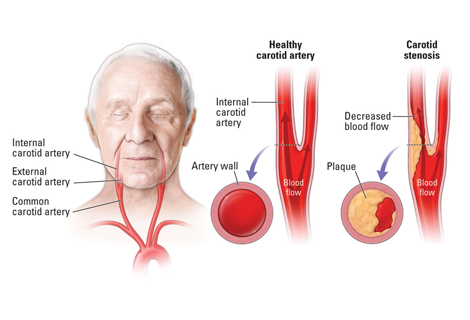Carotid Artery Disease
What is Carotid Artery Disease?
The carotid arteries are the main blood vessels that supply oxygenated blood to the brain, face, and head and are situated on each side of your neck. When either of these arteries becomes blocked with fatty substances (plaques) or narrowed, it hinders the normal blood flow. This condition is called Carotid Artery Disease or Carotid Artery Stenosis.
The narrowing of the blood vessels with plaque is called atherosclerosis. It can be developed on either of the two arteries or both. Carotid artery disease increases the risk of a stroke, leading to permanent disability or death.
What causes Carotid Artery Disease?
Carotid artery disease is caused by atherosclerosis - the buildup of fatty substances and cholesterol (plaques). Plaques are clumps of fatty debris that narrows and thickens the blood vessels. As it forms in the inner layers of the carotid arteries, it hinders the blood flow and increases the risk of stroke.
Various risk factors that develop carotid artery disease over time include:
-
High blood pressure
-
Smoking
-
Cholesterol
-
Diabetes
-
Obesity
-
Lack of physical activity
-
Family medical history
-
Sleep apnea
Symptoms of Carotid Artery Disease
During the early stages of carotid artery disease, you may not come across any visible symptoms. Plaques develop over time without any warning until a mini-stroke or a transient ischemic attack. A transient ischemic attack (TIA) is a temporary blood flow block to the brain that lasts for a few minutes.
Some of the common symptoms of a stroke or TIA include:
-
Sudden weakness or paralysis of an arm or leg of one side of the body
-
Sudden blurred vision and trouble speaking
-
Dizziness and severe headache
-
Confusion and loss of movement coordination
Call 911 and seek emergency care if you experience any of these symptoms. Do not turn a blind eye if you have any risk factors without symptoms. Early diagnosis can prevent a stroke or any further complications that lead to a stroke, like ruptured plaques or blood clot blockages.
Diagnosis of Carotid Artery Disease
As you may not experience any specific symptoms of carotid artery disease before a stroke or TIA, it is essential to get through regular physical examinations as recommended by your provider. Physicians can diagnose early by listening to an abnormal swooshing sound (bruit) over the carotid artery.
For further diagnosis and to detect blockages in the blood vessels, the following tests are recommended:
-
Carotid Doppler Ultrasound
-
Magnetic resonance angiography (MRA)
-
CT or MRI
-
Cerebral angiography
Treatment of Carotid Artery Disease
Carotid artery disease treatment is focused on controlling the disease and reducing the risk of stroke and its complications. Physicians will recommend lifestyle changes, medications, or surgery depending on the severity of the disease.
If the blockage is a mild and slow progression, it can be treated with lifestyle changes and medication to control blood pressure, cholesterol, and blood thinning. Lifestyle changes recommended will include:
-
No smoking
-
Exercising
-
Low cholesterol
-
Controlling diabetes
-
Regular medical checkup
-
Maintaining healthy diet
-
Low blood pressure
-
Limiting alcohol
If carotid artery disease is severe and you have experienced a stroke, the treatment would involve removing the blockages to increase blood flow and reduce the risk of future stroke. Surgical options would include:
-
Carotid endarterectomy
-
Carotid artery angioplasty and stenting



